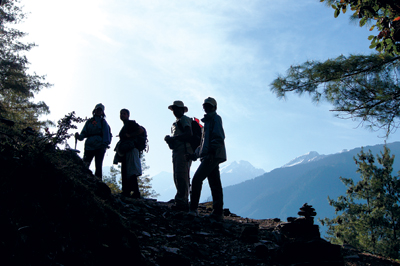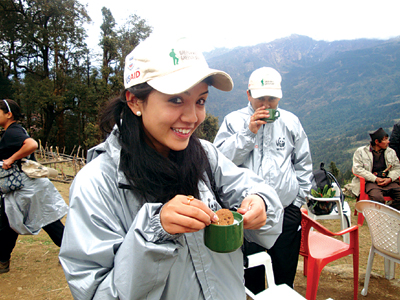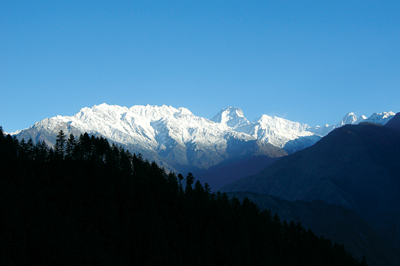Red panda, sisnoo soup and a volleyball tournament
 The famous Nepali poet Laxmi Prasad Devkota described Nepal as “Sundaar, Shanta, Bishal”- beautiful, peaceful and huge or ‘endless’. If you wish to experience the words of the famous poet, pick up your bag, put on your walking shoes and set out towards Langtang National Park. The pristine forest, the clear rivers, waterfalls and lakes, the colourful flowers, wildlife and birds, make every step you take worth while. Add to this the food, the local drinks, the music and cultural dances, the monasteries and the chortens and you will forget the effort you put in to get to these amazing sites. It is also a perfect venue to launch the “academic trek” in which people can get a real exposure to climate change, its impact, adaptation strategies and mitigation measures. Portions of the trail we walked on could be part of the proposed Great Himalayan Trail (GHT) that has been designed not just as a tourism product but will serve to provide connectivity for all settlements at the foothills of the Himalayas. It will form an integral part of Nepal’s adaptation plan against climate change.
The famous Nepali poet Laxmi Prasad Devkota described Nepal as “Sundaar, Shanta, Bishal”- beautiful, peaceful and huge or ‘endless’. If you wish to experience the words of the famous poet, pick up your bag, put on your walking shoes and set out towards Langtang National Park. The pristine forest, the clear rivers, waterfalls and lakes, the colourful flowers, wildlife and birds, make every step you take worth while. Add to this the food, the local drinks, the music and cultural dances, the monasteries and the chortens and you will forget the effort you put in to get to these amazing sites. It is also a perfect venue to launch the “academic trek” in which people can get a real exposure to climate change, its impact, adaptation strategies and mitigation measures. Portions of the trail we walked on could be part of the proposed Great Himalayan Trail (GHT) that has been designed not just as a tourism product but will serve to provide connectivity for all settlements at the foothills of the Himalayas. It will form an integral part of Nepal’s adaptation plan against climate change.
All renewables- solar and hydro
At each of the lodges and tea houses that we had our meals or spent the night, there was either solar power or clean hydro power. The area is fortunate to have three hydro power plants- Devighat, Trishuli and the Chilime with potential for many more. The world is today putting out ninety million tones of carbon dioxide into the atmosphere each day. Under normal conditions, the atmosphere should contain only 350 parts per million of carbon dioxide, but today has reached 387. Rasuwa district can easily become renewable energy self sufficient and ‘sell’ the surplus to Kathmandu and launch a domestic carbon trade mechanism. As it takes a lot of human effort to move goods up and down the slopes of Rasuwa, electricity powered ropeways can be a real possibility here. Biogas plants are also getting popular in the villages in the south of the district.
Red, white and blue
Each day we saw red and white rhododendron flowers along the trail against the clear blue sky. It did rain and it did snow, but it cleared up quickly to give us spectacular views of the flora and landscape of the area. Red, white and blue are the colors that make up the Nepali national flag and it is Nepal Tourism year. We all carried the flag, sticking out of each of our backpacks as we climbed up and walked down the slopes of the Himalayas. Recently there has been some debate as to whether we should change the flag. As you walk through Langtang, the blue becomes the sky and the numerous rivers, the white becomes the purity of the glaciers and the rhododendron, the red is the rhododendron and the blood of the entrepreneurial spirit of the people; and as long as the sun and moon comes up each day over the ridge to the east, this country will be there. The first night of our trek, we were greeted by a full moon. Red, blue and white also make up the flag of the USA whose 60 years in Nepal we were celebrating.
 Climate change
Climate change
The theme of the trek was to observe the impact of climate change and to see what efforts were underway to help and enable local people to adapt to these changes. We all had mixed feelings at the end of the trek. On the one hand climate change and its effects were real. We heard of changing rainfall patterns to new species of plants that were killing local livestock. We were told about change in habitat for local endangered species of flora and fauna and the unreliability of water supplies from traditional sources. A local woman had even composed a poem about climate change. What was really heart warming was to see how local communities had begun to create a seed bank to protect local gene varieties of crops. We saw how renewable energy sources were being harnessed to reduce pressure on the local forest such as biogas. We were delighted to see so much production of ‘organic’ food and to meet young people who were well educated about the complexity of climate change.
Trout and strawberry
Rural Nepali villages, are not just about maize and soybeans or millet and buckwheat anymore, but have created good food out of local stingy nettle or “sisnoo.” When prepared and served in style, the local dish can be quite a delight. Further, it is also a pleasant surprise to see so many framers have begun strawberry farming in the area. Others are big into the Himalayan Rainbow Trout farming. The people are so enterprising and will do well against all odds. One does see “ready made noodles” of different brands everywhere along with carbonated drinks. We do not need to do much except give the trekker a choice and educate them about the value creation in the local economy if we eat local food. The milk and the cheese of the local areas are of really good quality. Everywhere we also had yogurt, alcoholic drinks made from locally grown millet which were offered as a welcome gesture in silver decorated cups and served from traditional decanters.
 60 years and 50 years
60 years and 50 years
The people of the United States of America have been helping the people of Nepal for sixty years now. The US Agency for International Development USAID has helped so many Nepalis to acquire higher education and various trainings. World Wildlife Fund (WWF) has been helping protect Nepal’s globally unique flora and fauna for fifty years. The green hike, green planet trek was part of these anniversary celebrations. The American people have given so much to Nepal including highways, higher education institutes, ropeways, and so much more. WWF has helped Nepal become a global leader in conservation of rich flora and fauna. Both deserve our gratitude and commitment to do more for ourselves as Nepalis. We need to take ownership of our challenges and begin to become proactive. Climate change, adaptation and mitigation could very well be an area where Nepal could take the lead. We watched the final game of a local volleyball tournament and gave away the WWF sponsored Red Panda Trophy and medals to the winning team!
Rasuwa Gaddi to Galchi
The trade volume between India and China in 2008 had exceeded a value of US $ 50 billion. The question that many ask is, can this go through Nepal? We do need to be organized if Nepal is going to take advantage of this instead of just a handful of “clever people” as in the past. The Rasuwa Gaddhi to Galchi highway is nearing completion with support from the Asian Development Bank (ADB). We drove back along this road and began a conversation centered around how this may serve as a green corridor between Nepal and Tibet, China that will enhance conservation and management of natural resources. Local people in Rasuwa aspire to send fresh “organic” food each day into Tibet. There is talk of a “green special economic zone” in the area as well. We have to make sure that illegal wildlife body parts do not travel on this road. We must also ensure that the “clean” river that currently flows along the highway does not suffer the same fate as others in the past.
Just do it
Langtang is waiting for you. There cannot be an excuse not to go enjoy and pamper yourself. It is a good place to mix work and holiday as well. Over the next weeks and months, many pilgrims will be going up to Gosaikunda. Choose when and how you want to go, but do go!
Tired of the three Durbar Squares?
As Nepalese, we are all too familiar with the squares of Kathmandu, Bhaktapur and Patan whether it’s a...










